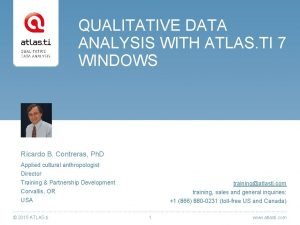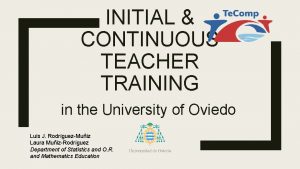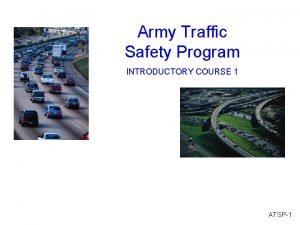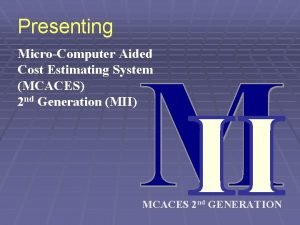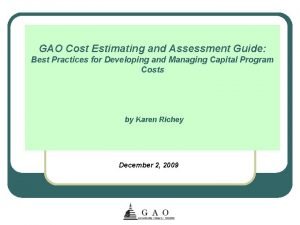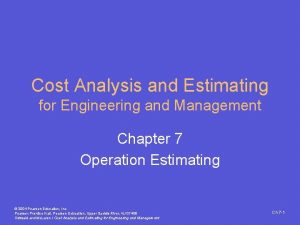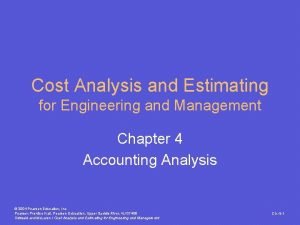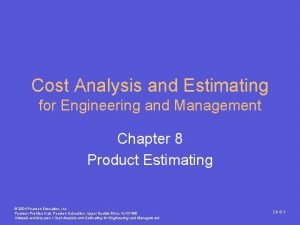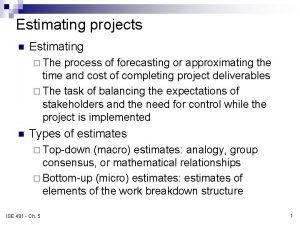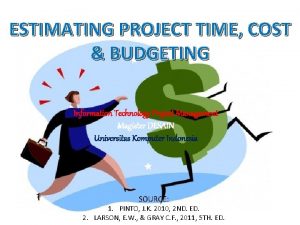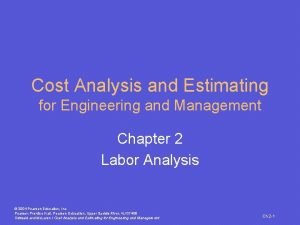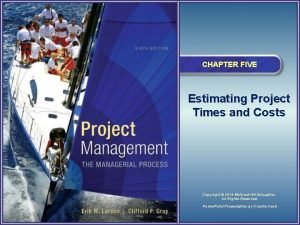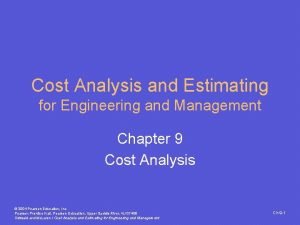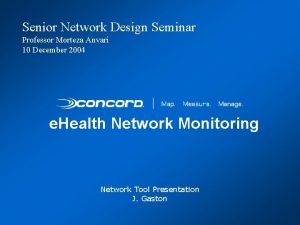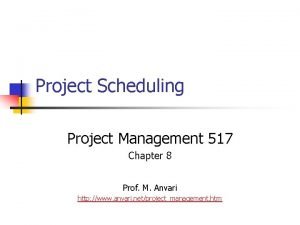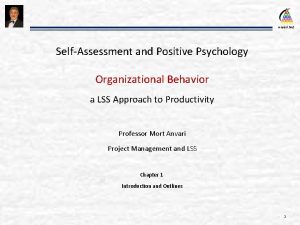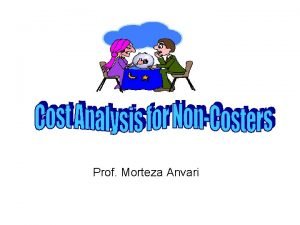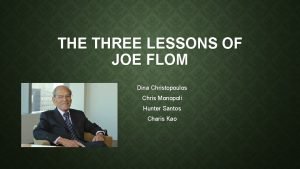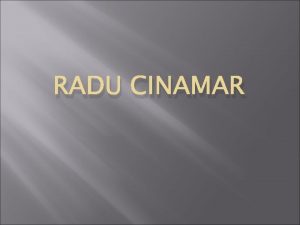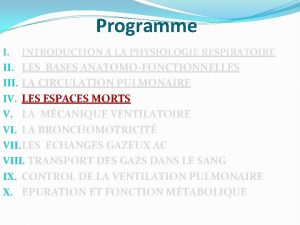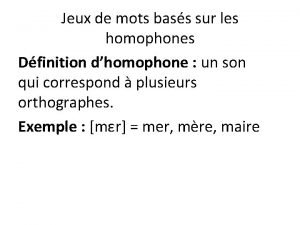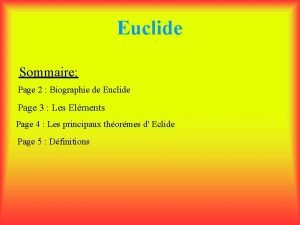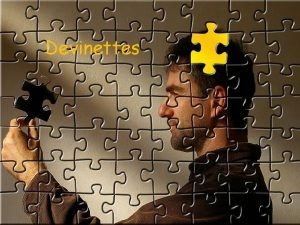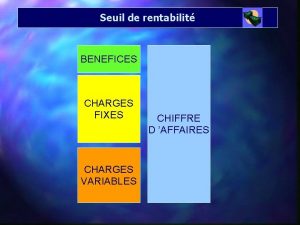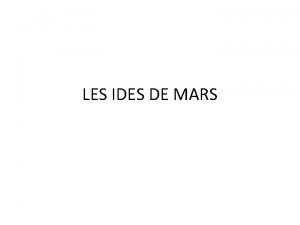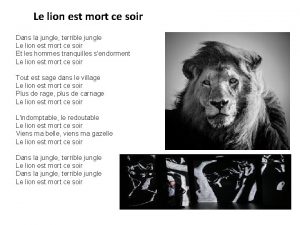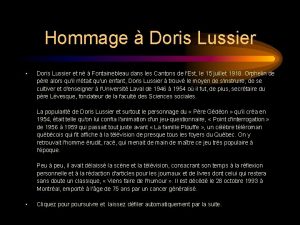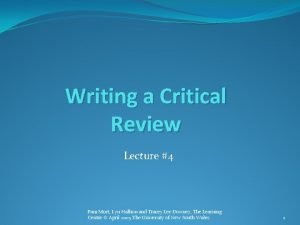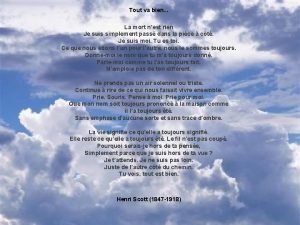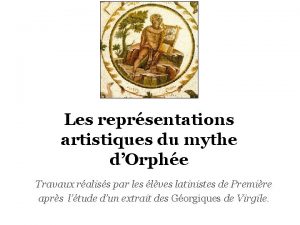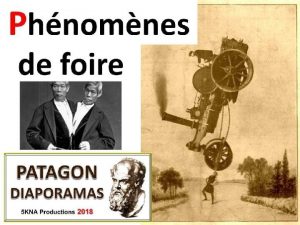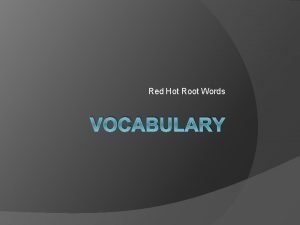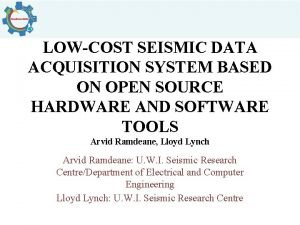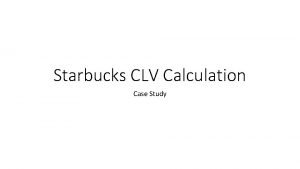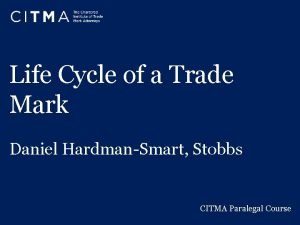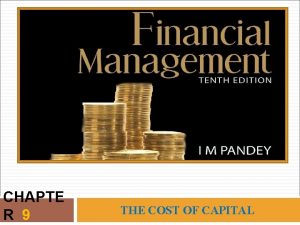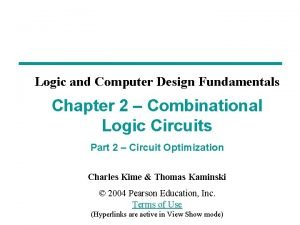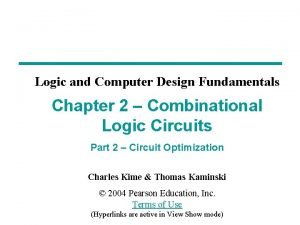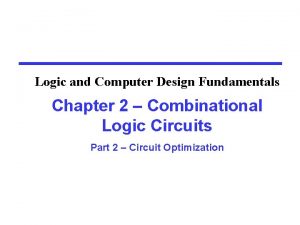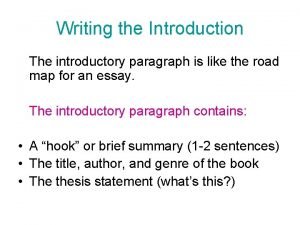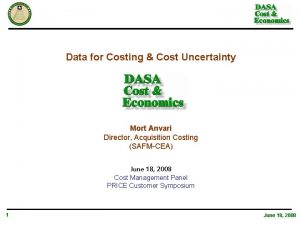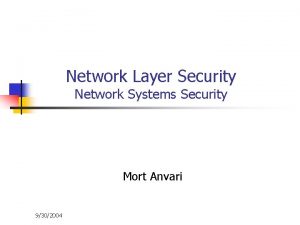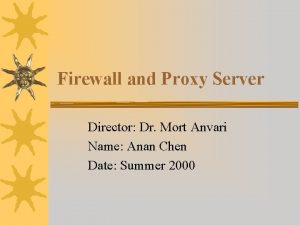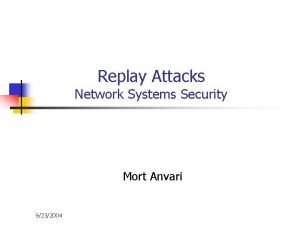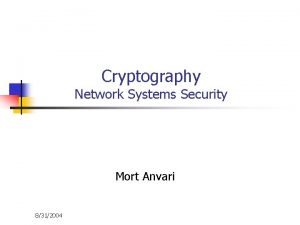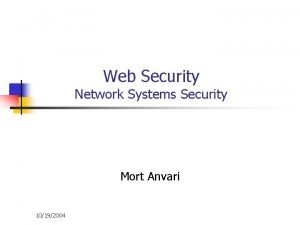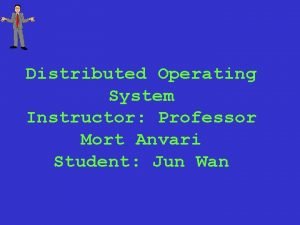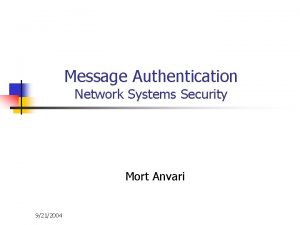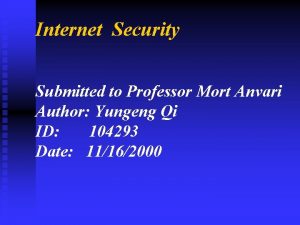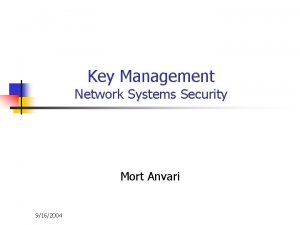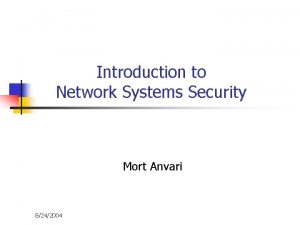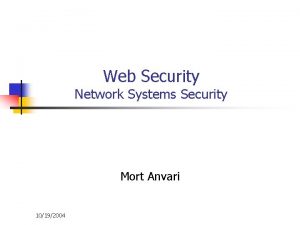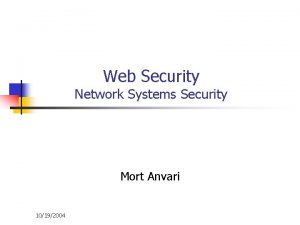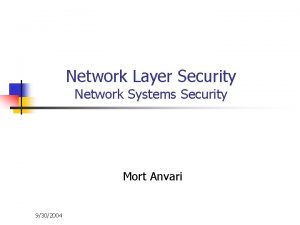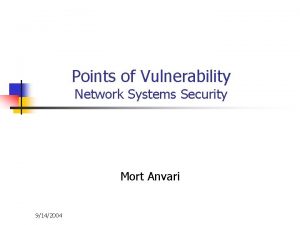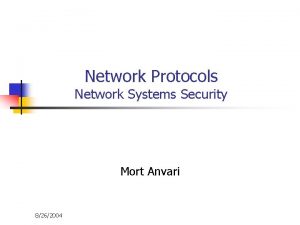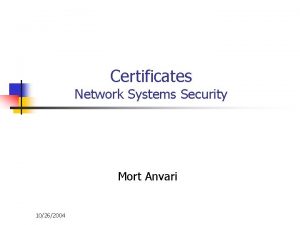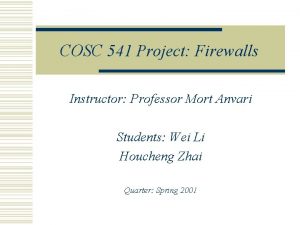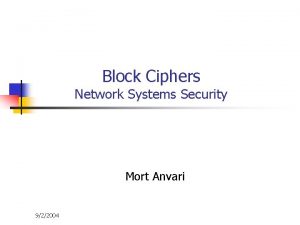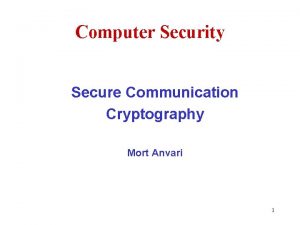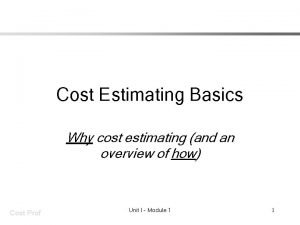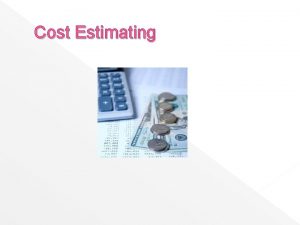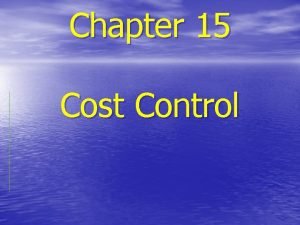Acquisition Cost Estimating Introductory Course Mort Anvari Acquisition
















































































- Slides: 80

Acquisition Cost Estimating Introductory Course Mort Anvari Acquisition Costing Directorate Mort. Anvari@us. army. mil (703) 601 -4200 19 July 2006

HQDA SA UNDER ASA (CW) ASA(FM&C) FO RB ASA (I&E) CSA VCSA ASA (MR&A) Budget ASA (ALT) DASA-CE

Situation • You have just been tasked to develop a cost estimate, that is, a professional opinion about the cost of an item, a service or a thing. • Let’s discuss a process for organizing and developing this cost estimate. 3

Cost Estimating Process • Definition & Planning – – – • • Purpose of the Estimate Defining the System and Schedule Ground rules & Assumptions Estimating Approach Estimating Team Data Collection and Analysis Estimate Formulation Review and Presentation Final Documentation 4

Definition and Planning • Influences the success of the estimate • Understanding the requirements and how you approach the process will establish the guidelines and procedures for the estimate. • Ask lots of questions…They help you understand the requirement. 5

Questions • Why is this cost estimate needed? • What decisions are pending on the results of this estimate? • Will the estimate be briefed and to whom? • Will the results be incorporated into some document? • What does the recipient expect to have included or excluded? • What excursions or variations from the baseline are anticipated? 6

Questions Continued • What are the program and funding constraints especially if the program is a Joint Program? • What are the time constraints for this estimate? • What is the acquisition phase of the program? • Is the program definition mature? • Does technology exist today to design, develop, test and manufacture the system? • What is the interrelationship with other systems? • Are there previous contracts? How many? What type? • How have the contractors performed to date? 7

Definition and Planning Know Purpose of the Estimate • Main purposes of estimates: – Budget Formulation – Comparative Studies – Source Selection 8

Types of Cost Estimates • Life Cycle Cost Estimate (LCCE): Cradle-to-grave estimate includes R&D, production, operations/support, and disposal • Independent Cost Estimate (ICE): LCCE of most likely cost developed by an independent organization • Budget Estimate: For inclusion in budget to support current activities • Rough-Order-of-Magnitude (ROM): Pre design effort, with very little specific information about the project • Analysis of Alternatives (Ao. A): Evaluates costs, benefits, advantages and disadvantages of different alternatives • Activity Based Costing (ABC): Accounting methodology that assigns resources and overhead costs to activities, products and services to support making decisions about pricing, outsourcing, capital expenditures and operational efficiency There are many types of cost estimates, each with a different purpose. Know the purpose of the cost estimate before you start 9

Purpose of Estimate Budget Formulation Estimates • • Program Office Estimate (POE) Component Cost Analysis (CCA) Independent Cost Estimate (ICE) What-if exercises Rough Order of Magnitude (ROM) Cost Risk Analysis Should Cost Estimates CAIV 10

Purpose of Estimate Comparative Studies Estimates • Making cost & benefit comparisons between alternatives – Economic Analysis (EA) – Analysis of Alternatives (Ao. A) – Force Structure – Trade-off Studies – Source Selection – Prioritization 11

Definition and Planning Defining the System • Adequate description of the technical and program characteristics of the system • What are the physical and performance characteristics? • What are the development, production, and deployment schedules? • How many systems are to be produced? • How will the systems be supported: contract, inhouse, two or three levels of maintenance? 12

Defining the System Integrated System Schedule

Defining the System Work Breakdown Structure (WBS) • WBS defined in MIL-HDBK-881 as: – product-oriented breakdown of hardware, software, services, data and facilities that define the system. • WBS breaks a total job down into manageable pieces & portrays the way work is to be done. • WBS displays a company’s reporting structure. • Program managers may cite MIL-HDBK-881 “for guidance only” in contract solicitations. 14

MIL-Handbook-881 (WBS)

Defining the System COST ELEMENT STRUCTURE (CES) 1. 0 Research Development Test & Evaluation (RDT&E) 2. 0 Production 3. 0 Military Construction (MILCON) 4. 0 Military Pay and Allowances (MPA) 5. 0 Operating and Maintenance Army (OMA) 16

Defining the System COST ELEMENT STRUCTURE – 1. 0 RDT&E CES# ELEMENT: FY 00 C$M TY$M $ 39. 039 M 1. 01 DEV. ENG. 0. 408 1. 02 PEP 0. 457 1. 03 DEV. TOOL. 110. 421 1. 04 PROTO MFG. 78. 266 1. 05 SEPM 11. 112 1. 06 SYS T&E 1. 989 1. 07 TRAINING 3. 439 1. 08 DATA 4. 897 1. 09 SUPP EQUIP. 0. 0 1. 10 DEV. FACILITIES 0. 968 1. 11 OTHER $38. 260 M 0. 386 0. 450 107. 724 76. 363 10. 927 1. 954 3. 413 4. 758 0. 0 0. 928

Defining the System COST ELEMENT STRUCTURE – 2. 0 PROCUREMENT CES# ELEMENT: FY 06 C$M TY$M 2. 01 NON REC PROD. $ 16. 110 M $ 16. 583 M 2. 02 REC. PROD 1, 169. 348 1, 312. 377 2. 03 ENG. CHG 0. 0 2. 04 SEPM 116. 637 132. 258 2. 05 SYS T&E 12. 564 14. 437 2. 06 TRAINING 28. 880 31. 499 2. 07 DATA 2. 073 2. 300 2. 08 SUPP. EQUIP. 146. 460 158. 304 2. 09 OPER. /SITE/ACT. 0. 0 2. 10 FIELDING 89. 525 101. 635 2. 11 TRAIN. AMMO/MSLS 59. 001 79. 482 2. 12 WAR RESV. 0. 0 0. 0 2. 13 MODS 236. 619 280. 729 2. 14 OTHER 51. 739 64. 129

Defining the System COST ELEMENT STRUCTURE – 3. 0 MILCON CES# ELEMENT: FY 06 C$M TY$M 3. 01 DEVELOP. CONSTRUCTION 3. 02 PRODUCT. CONSTRUCTION 3. 03 OPERATION/SITE ACTIVATION 3. 04 OTHER MILCON

Defining the System COST ELEMENT STRUCTURE – 4. 0 Military Pay&Allowances (MPA) CES# ELEMENT: FY 06 C$M TY$M 4. 01 CREW 4. 02 MAINTENANCE 4. 03 SYSTEM SPECIFIC SUPPORT 4. 04 SEPM 4. 05 REPLACEMENT PERSONNEL 4. 06 OTHER MPA

Defining the System COST ELEMENT STRUCTURE – 5. 0 Operating & Maintenance Army (OMA) CES# ELEMENT: FY 06 C$M TY$M 5. 01 FIELD MAINT. , CIV LABOR 5. 02 SYS. SPECIFIC BASE OPS 5. 03 REPLENISHMENT DLRs 5. 04 REPLEN. CONSUMMABLES 5. 05 POL 5. 06 END ITEM MAINTENANCE 5. 07 TRANSPORTATION 5. 08 SOFTWARE 5. 09 SEPM 5. 10 TRAINING 5. 11 OTHER OMA

Defining the System Cost Analysis Requirements Description (CARD) • Source of a system’s description • Describes important features • Is provided to other groups preparing cost estimates • Helps ensure all groups are costing out the same “program. ” • Prepared by program office; approved by Do. D Component Program Executive Officer 22

Defining the System Cost Analysis Requirements Description (CARD) Divided into a number of sections, each focusing on a particular aspect of the program being assessed. 1. 1. 1 System Description 1. 1. 4 Government-Furnished Equipment and Property 1. 2. 1 Technical and Physical Description 1. 2. 1. x (. . x. . ) Subsystem Description 1. 2. 1. x. 3 Material, Processes, and Parts 1. 2. 2 Software Description. 23

Defining the System Cost Analysis Requirements Description (CARD) Continued 24

Defining the System CARD Continued

Definition and Planning Ground Rules & Assumptions • State the conditions which must take place in order for the estimate to be valid • Ground rules and assumptions must be documented since changes in these areas provide an audit trail for changes in the cost estimate. 26

Definition and Planning Select the Estimating Approach • Techniques available – Analogy – Parametric – Engineering – Extrapolation – Expert Opinion Select the technique that is most applicable to a specific WBS element 27

Definition and Planning Estimating Methods • Analogy – Basic Comparison – Factors • Parametric – Regression Analysis • Engineering – Detailed • Expert Opinion – Committee – Delphi 28

Cost Estimating Methods Analogy Method • Based on direct comparison with historical information of similar existing activities, systems, or components. • Compares new system with one or more existing similar systems where there is accurate cost and technical data. • Analyst must show validity of comparison. 29

Cost Estimating Methods Analogy Method • Based on known costs of a similar program • Adjustments for complexity, technical, physical • Strengths – Based on representative experience – Less time consuming than others – Can be used as a check on other techniques • Weaknesses – Small sample size – Heavy reliance on judgment – Sometimes difficult to identify analogy and associated costs 30

Analogy Estimating with Factors Cost(New) = Cost(Old) x Adjustment Factor Element Old Sys 1 Old Sys 2 Old Sys 3 New Sys Airframe $500/lb Engine 2 M/Unit 3 M/Unit 5 M/Unit. 8 x. S 3 Avionics $3 K/lb Payload 6 M/Unit 8 M/Unit 7 M/Unit. 65 x. S 1 $250/lb $2 K/lb $750/lb $4 K/lb 1. 25 x. S 1 1. 0 S 2 31

Cost Estimating Methods Parametric Method • Known as Statistical Method or Top Down Method • Relates cost to physical attributes or performance characteristics • Uses database of elements from similar systems • Uses multiple systems • Most beneficial in earlier stages of the system or project life cycle 32

Cost Estimating Methods Parametric Method • Statistical relationships between cost and physical or performance parameters of past systems. • Strengths – Captures major portion of cost – Quick what if type estimates • Weaknesses – Less detailed – Getting accurate data 33

Cost Estimating Methods Parametric Method (Extrapolation) • Use historical values to establish a trend for the future. • Example problem: Given the actual productivity and labor rates in the given table. How much will it take to complete a 3 -year software development project of 10 K lines of code, if 50% is completed in the second year and 25% is completed in first and third years? 34

Learning Curve Theory As the quantity of a product produced doubles, the man-hoursper-unit expended to produce the product decreases at a fixed rate or constant percentage (usually 10% to 20%).

Learning Curve Theory Factors Contributing to Efficiency • Job familiarization by both production workers and supervisory personnel. • Changes in product design which do not materially affect the product, but result in increased ease and speed of production. • Changes in tooling, machinery, and equipment which simplify or speed up the production process. • Improved production planning and scheduling, and improvements in production techniques and operational methods. • Improvements in shop organization, engineering coordination and liaison. • Improvements in the handling and flow of materials, and in the materials and parts supply systems

Learning Curve Theory The table is based on the assumption that the first unit required 100 person-hours to produce. The table indicates a constant rate of reduction of 20% for each doubling of the unit number; the value of the second and each succeeding item in the table is 80% of the value of the preceding item. TABLE FOR FIGURES F-1 -1 and F-1 -2 Unit No. 1 2 4 8 16 32 64 Unit Person-hours 100. 00 80. 00 64. 00 51. 20 40. 96 32. 77 26. 21

Learning Curve Theory 80% Unit Curve on Arithmetic Paper

Learning Curve Theory 39

Learning Curve Theory Uses – Evaluating contract production costs. – Assessing impact of production interruptions, product changes and production rate change. – Rate of improvement experienced by a particular contractor on a prior product may be indicative of rate of improvement expected on new product of similar size, complexity, and construction. – Improvement curve pattern experienced in the production of past item can be extended to calculate costs of future items. 40

Cost Estimating Methods Engineering Method • Known as bottom up method • Requires extensive knowledge of system characteristics • Divide into segments; estimate costs for each segment • Combine segments plus integration cost • Uses a combination of cost estimating methods • Detailed knowledge of new technologies may not be available. 41

Cost Estimating Methods Engineering Method • Strengths – Detailed • Best when long stable production process • Weaknesses – Requires a lot of time – Cost – Cannot be used until system well defined 42

Cost Estimating Methods Expert Opinion Method • Subjective judgment of an experienced individual or group • Use if time does not permit a more thorough analysis • Document source(s) of opinion of experts • List attributes of the source(s) Example: Delphi Technique 43

Cost Estimating Methods Expert Opinion Method • Consulting with one or more experts who use their knowledge and experience to arrive at an estimate • Group techniques include – Consensus (Committee) – Delphi • Strengths and weaknesses 44

Expert Opinion Method Delphi Technique • • • Query expert opinion from group Seek information from each expert Summarize the results Send report to each expert Gather second opinion after each individual reviews report • Summarize results • Iterative process continues until the experts reach a consensus, or near‑consensus. 45

Expert Opinion Method Example Labor type Hours Needed % of Total Hourly Rate Hrs %*rate Senior Engineer 1000 $13 10. 5 $1. 37 Design Engineer 3000 $11 31. 6 $3. 48 Tool & Die 500 $11 5. 3 $. 58 5000 $9 52. 6 $4. 73 Machinist Totals 9500 $10. 16 46

Cost Estimating Methods Laying Out the Estimating Approach Aircraft System – sum of level II elements (cross-check with analogy) Air Vehicle – sum of level III elements Airframe – CERs Air Vehicle Software – Expert Opinion Propulsion – CERs Avionics – Analogy Armament – Catalog Price System Eng/Program Mgt – Factor of Air Vehicle System Test & Evaluation – Factor of Air Vehicle Training – Factor of Air Vehicle Data – Factor of Air Vehicle Peculiar Support Equipment – Factor of Air Vehicle Initial Spares – Factor of Air Vehicle 47

Data Collection and Analysis • The direction we take in collecting historical data will be determined by our choice of estimating methodologies. • This step may also dictate a change in estimating approach due to the availability or non-availability of certain data. • Data collection is not limited to cost data. We must also collect technical and program data if we want the total picture of the historical systems. This will help us ensure the comparability of the systems that we are collecting data on with the system we are estimating. 48

Data Collection and Analysis Most Difficult Task in Cost Estimating • Data Sources – Data Types: Cost/Resource, Technical, Program – Categories: Primary, Secondary • Data Problems – Wrong Format – Matching up – Definition – Temporal Factors - comparability • Normalization • Data Location 49

Data Collection and Analysis • Collection and analysis represent a significant amount of the overall estimating task in terms of time. The analysis will include decisions on what programs to include in the data set to whether to truncate lot data on a program for which you are calculating a learning curve. • Document data in your analysis, and any assumptions you make 50

Estimate Formulation • We have defined our tasks, planned the estimate, assigned cost responsibilities, and performed data collection and analysis. • Here we apply our estimating methodologies and tools: develop the factors, analogies, CERs, and learning curves. • We will aggregate the various cost elements into development, production, and O&S estimates, fiscally spread the costs, and apply inflation. 51

Estimate Formulation Life Cycle Cost (LCC) Total cost to the Government of a system over its entire life. LCC: • Serves as cost input for decisions whether or not to continue, modify, or terminate development, production, and fielding • Provides basis for budget requests to Congress 52

Total Ownership Cost (TOC) Total Ownership Cost Includes All Costs Associated With the Research, Development, Procurement, Operation, Logistical Support and Disposal of an Individual Weapon System Including the Total Supporting Infrastructure That Plans, Manages and Executes That Weapon System Program Over Its Full Life. And: "The Cost of Requirements for Common Support Items and Systems That Are Incurred Because of Introduction of That Weapon System. " But: "Excludes Indirect "Non-linked" Infrastructure Costs That Are Not Affected by Individual Weapon Systems' Development, Introduction, Deployment or Operations. “ Generally, TOC Is Synonymous With Life Cycle Costs.

Army Tools for Total Ownership Cost Estimating Life Cycle Cost Management Tools

Automated Cost Estimator (ACE) • Automated Cost Estimator (Ace)—is a Model-building Tool. Part Spreadsheet, Part Database, It Incorporates Enough Structure to Eliminate Most of the Automation Tasks You Would Have to Perform If You Used a Spreadsheet, Yet It’s Flexible Enough to Perform Nearly Any Kind of Analysis. The Analyst’s Productivity Is Increased Through Built-in Inflation, Learning, Time Phasing, Documentation, Sensitivity/what-if, and Other Analysis Capabilities.

Automated Cost Data Base (ACDB) ACDB Is ACEIT’s Automated Cost Database. Just As ACE Is a Modelbuilding Tool, ACDB Is a Database- Building Tool. It Contains Powerful Database Entry and Administration Tools to Enable Any Site/office to Create Its Own Tailored Database. When You Populate It, ACDB Lets You Search and Retrieve Cost, Schedule, Technical, and Programmatic Data.

Operating Support (O&S) Costing Installation Cost (Base Operations / Real Property Maintenance) Operating & Support Management Information System (OSMIS) Force Cost Model(s)


Force Costing / Models FORCES: Unit Operations & Support • Updated Annually • Provides Input to 5 Defense Models • Supports 9 Separate Study Groups • Avg 25 Major Estimates Per Year

OSMIS U. S. Army Cost & Economic Analysis Center OSMIS Operating & Support Management Information System • • • Parts (NSN Level) & Fuel Ammunition Intermediate Maintenance Depot Maintenance Activity Data (miles/Hours) Year of Manufacture Database

Review and Presentation • We want to ensure that the estimate is reasonable, realistic, and complete. • Reasonableness addresses areas such as: using appropriate and acceptable methodologies; presenting methodologies systematically; the use of relevant data; and ensuring that assumptions are valid and clearly stated. 61

Review and Presentation (Continued) • The realism test checks to see if the assumptions and ground rules are consistent with the statement of work and if the costs are in line with historical data. • We evaluate completeness by determining whether the estimate includes all the work stated in the request for proposal and whether the costs are traceable and reconcilable. 62

Final Documentation • Provide the means for other analysts to get the same results that we have in our cost estimate. • Providing good directions and a clear trail to follow are essential in having an estimate that can be replicated. • Provide step-by-step documentation of the methodologies, supporting data, ground rules, and assumptions, equations, examples, etc. , • Ability to interpret or evaluate someone else’s cost documentation is as important as ability to prepare good cost documentation. 63

Cost Estimating Process Definition Data Collect Planning Normalize Estimate Formulation Review/ Presentation Final Document DOCUMENTATION 64

Cost Estimating Process Questions • We have talked about a process for estimating the project as well as various techniques for estimating specific cost elements. • Questions? • Let’s talk about the current scenario of cost estimating for SMART. 65

Cost Review Board (CRB) Process Overview PM - develops Program Office Estimate (POE) Cost Review Board is a quality assurance built in the Cost Analysis Process in support of decisions and PPBES CRBWG - Reconciles & Recommends ACP to CRB CEAC - develops Independent Cost Estimate Recommended ACP Briefed to CRB Principles ASA(FM&C) Approves Army Cost Position • ASARC • OSD • PPBES • APB • CAIV • AOA • OSD CAIG develops ICE for ACAT ID programs as part of the DAB process • CEAC develop ICE for ACAT IC programs 66

Cost Analysis Requirement MS I MS 0 O L D Concept Exploration MS III Program Definition & Risk Reduction Engineering & Manufacturing Development (EMD) Production, Fielding/ Deployment Cost Estimates Needed A N E W C B Concept Exploration Component Advanced Development Review Concept & Technology Development Pre-Systems Acquisition System Integration System Demo Production Readiness & LRIP Review System Development& Demonstration Rate Production & Deployment Review Support Production & Deployment Systems Acquisition (Engineering and Manufacturing Development, Demonstration, LRIP & Production) Sustainment

Cost Analysis Domain Inputs (Descriptions) Requirements Acquisition Assumptions Design Parameters Risk Assessment Process (Models) Cost Analysis Process Databases, Tools, & Models Outputs (Costs) ASARC CAIG, DAB APB PPBES AOA Types of Cost Studies Performance Based and Design Based Cost Models Currently do not Exist

Army Cost & Economic Analysis Center’s M&S Architecture Top Level Tool Requirement Models 1. Cost tools to communicate with engineering and requirements models. 2. Component level to assist engineers and designers with cost capability. 3. Integrated Performance-Based Cost Model

Top Level Tool Requirement Models Cost Tools Interface Protocols ACEIT ACDB Interface Protocols Engineering Tools SEER Pro-E PRICE CAD CAI* Auto-CAD Databases Others *Composite Affordability Initiative Others

Cost As An Independent Variable (CAIV) • Best time to reduce cost is early in the process. • Involves the stakeholders in the process. • Cost tradeoffs must be addressed early in the acquisition process and embedded in program requirement documents, Request For Proposals (RFPs), contract provisions, and source selection process. 71

CAIV Process • Set realistic but aggressive cost objectives early in acquisition program • Manage risks • Track progress using appropriate metrics • Motivate Government and industry managers to achieve program objectives • Incorporate incentives to reduce O&S costs for fielded systems

Analysis of Alternatives • Set realistic, aggressive cost objectives early in development • Manage risks • Track progress with appropriate metrics • Motivate government/industry managers to achieve program objectives • Incorporate incentives to reduce O&S costs for fielded systems.

Reduce Total Ownership Cost (TOC) with M&S • Link Cost/Performance Models to Engineering Design Models to reduce TOC & Sustainment • Optimize performance/cost of system by addressing in early design phase 74

Cost Terminology • • Recurring vs Nonrecurring costs Direct Costs vs Indirect Costs Fixed Costs vs Variable Costs Overhead Costs Sunk Costs Opportunity Costs Life Cycle Costs Cost is not a uniquely defined term 75

Cost Terminology • Recurring Costs are those costs that are repetitive and occur when a company produces similar goods or services on a continuing basis. A fixed cost that is paid on a repeatable basis is a recurring cost (i. e. , rent). For example, for a company that provides architectural services, office space rental - which is a fixed cost - is also a recurring cost. Can be tied to Quantity Produced. • Nonrecurring Costs are those costs that are not repetitive, even though the total expenditure may be cumulative over a relatively short period of time. Nonrecurring costs typically involve developing or establishing a capacity to operate. For example, the cost of purchasing real estate upon which a plant will be built is a nonrecurring cost, as the cost of constructing the plant itself. Cannot be tied to Quantity. 76

Cost Terminology • Direct Costs are those costs that can be reasonably measured and allocated to a specific output/product or work activity – Typical direct costs include the labor and material costs directly associated with a product, service, or construction activity • Indirect Costs are those costs that are difficult to attribute or allocate to a specific output or work activity. Costs that involve too much effort to allocate directly to a specific output; instead, they are allocated through a selected formula (i. e. , proportional to direct labor hours or direct material dollars). Cannot be tied to a specific product. – Typical indirect costs include the costs of common tools, general supplies, equipment maintenance 77

Cost Terminology • Fixed Costs are those costs which are unaffected by changes in output quantity over a feasible range of operations for the available production capability – Typical fixed costs include insurance and taxes on facilities, general management and administrative salaries, and interest costs on borrowed capital. These are Non-Recurring Costs. • Variable Costs are those costs associated with production that vary with quantity of output. Variable costs are the primary costs that should be considered when making an economic analysis of a proposed change to an existing operation. – Typical variable costs include material and labor; these are 78 Recurring Costs

Cost Terminology • Overhead Costs consist of plant operating costs that are not direct labor or direct material costs. (Indirect costs, overhead, and burden are terms that are sometimes used interchangeably) – Typical overhead costs include electricity, general repairs, property taxes, supervision – Various methods are used to allocate overhead costs among products, services, or activities • Most commonly used methods involve allocation in proportion to direct labor costs, direct labor hours, direct materials costs, the sum of direct labor and material costs, or machine hours (refer to example) 79

Cost Terminology • Sunk Costs are those costs that have occurred in the past and have no relevance to estimates of future costs and revenues for alternative course of action – Common to all alternatives, not part of prospective cash flows in the future – Not used in cost analysis but required in OMB-300 • Opportunity Costs are those costs incurred because of the use of a limited resource. The opportunity to use that same resource to monetary advantage in an alternative use is foregone. – The cost of the best rejected or foregone opportunity – Often hidden or implied 80
 Www.atlasti.com
Www.atlasti.com Advanced maxqda course
Advanced maxqda course Army traffic safety course
Army traffic safety course Army traffic safety introductory course
Army traffic safety introductory course Mii cost estimating
Mii cost estimating Gao cost estimating and assessment guide 2020
Gao cost estimating and assessment guide 2020 Cost analysis and estimating for engineering and management
Cost analysis and estimating for engineering and management Cost analysis and estimating for engineering and management
Cost analysis and estimating for engineering and management Cost analysis and estimating for engineering and management
Cost analysis and estimating for engineering and management Estimating project time and cost
Estimating project time and cost Top down budgeting vs bottom up budgeting
Top down budgeting vs bottom up budgeting Cost analysis and estimating for engineering and management
Cost analysis and estimating for engineering and management Estimating project time and cost
Estimating project time and cost Cost analysis and estimating for engineering and management
Cost analysis and estimating for engineering and management Morteza anvari
Morteza anvari Anvari chapter 9
Anvari chapter 9 Anvari.net chapter 6
Anvari.net chapter 6 Cost analyst
Cost analyst Difference between second language and foreign language
Difference between second language and foreign language Joe flom
Joe flom Viitor cu cap de mort
Viitor cu cap de mort Espace mort anatomique
Espace mort anatomique Mort pierre bachelet
Mort pierre bachelet Histoire du friauche
Histoire du friauche Homophone de mort
Homophone de mort Maxalexis date de mort
Maxalexis date de mort Comment est mort pouchkine
Comment est mort pouchkine Quand est né et mort euclide
Quand est né et mort euclide Je nais et meurs dans l'eau. qui suis-je
Je nais et meurs dans l'eau. qui suis-je Autoportrait au passeport juif felix nussbaum
Autoportrait au passeport juif felix nussbaum Point mort graphique
Point mort graphique Vincenzo camuccini la mort de césar
Vincenzo camuccini la mort de césar Solomon linda le lion est mort ce soir
Solomon linda le lion est mort ce soir Le souvenir doris lussier
Le souvenir doris lussier Pam mort
Pam mort La mort nest rien
La mort nest rien Henry scott holland l'amour ne disparaît jamais
Henry scott holland l'amour ne disparaît jamais Orphée et eurydice corot
Orphée et eurydice corot Triomphe de la mort
Triomphe de la mort François coppée la mort des oiseaux
François coppée la mort des oiseaux Saule pleureur mort
Saule pleureur mort Maurice tillet mort
Maurice tillet mort Words with the root viv
Words with the root viv Heros de la mort aux trousses
Heros de la mort aux trousses Lee radziwill époux
Lee radziwill époux Himenopteros
Himenopteros La peine de mort argument contre
La peine de mort argument contre Ltv coca
Ltv coca Cost of customer acquisition (coca)
Cost of customer acquisition (coca) Low cost seismic acquisition
Low cost seismic acquisition Starbucks customer lifetime value
Starbucks customer lifetime value Mexico trips todeals
Mexico trips todeals Flemish bond t junction
Flemish bond t junction Course title and course number
Course title and course number Chaine parallèle muscle
Chaine parallèle muscle Citma paralegal course cost
Citma paralegal course cost Cost accumulation and cost assignment
Cost accumulation and cost assignment Cost accumulation and cost assignment
Cost accumulation and cost assignment Manufacturing cost vs non manufacturing cost
Manufacturing cost vs non manufacturing cost Job costing definition
Job costing definition Wacc example
Wacc example Controllable expenses examples
Controllable expenses examples Cost accumulation and cost assignment
Cost accumulation and cost assignment Manufacturing cost vs non manufacturing cost
Manufacturing cost vs non manufacturing cost Standard cost variance
Standard cost variance Book value of debt
Book value of debt What is a period cost on the income statement
What is a period cost on the income statement Cost control and cost reduction difference
Cost control and cost reduction difference Definition of standard costing
Definition of standard costing Literal cost gate input cost
Literal cost gate input cost Distinguish between average cost and marginal cost
Distinguish between average cost and marginal cost Cost control and cost reduction difference
Cost control and cost reduction difference Job order cost and process cost systems
Job order cost and process cost systems Ordering cost and carrying cost
Ordering cost and carrying cost Literal cost gate input cost
Literal cost gate input cost Literal cost gate input cost
Literal cost gate input cost Trade offs and opportunity cost
Trade offs and opportunity cost Cost control and cost reduction project report
Cost control and cost reduction project report Cost control and cost reduction project report
Cost control and cost reduction project report Cost behavior and cost-volume-profit analysis
Cost behavior and cost-volume-profit analysis Purpose of introduction
Purpose of introduction
